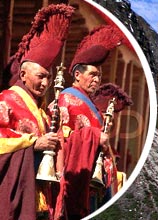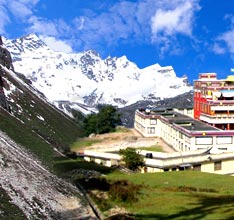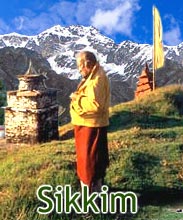Kanchenjunga National Park can be termed as a huge
asset to the ecological conserve of India. Sited on the threshold of Mt.
Kanchenjunga, the National Park got its name from this third highest
peak of the world. This park of national importance, also embraces the
gigantic Zemu glacier in its periphery. Sprawled across an area of 850sq
km, Kanchendzonga National Park is known to be the largest wildlife
reserve in Sikkim.
Kanchenjunga Park is extended in a large expanse and due to this; most
of its part has not been explored yet. In order to explore this vast
park, one is required to obtain permit and fulfill other formalities,
which are required by the government of Sikkim. Ranging between
altitudes of 1829 to 8585 meters, Kanchenjunga National Park (KNP)
touches the feet of Mt Kanchendzonga on its western border.
The term Kanchenjunga literally means 'the Abode of Gods consisting of
Five Treasure Houses'. These five treasure houses imply the five lofty
peaks of Mt Kanchenjunga including Mt Narshing, Mt Pandim, Mt Siniolchu,
Mt Simvo and Mt Kabru. The first three peaks are the most beautiful
amongst all of them and stand tall in the locale of KNP. The varied
elevation has given a perfect base to the rich collection of flora and
fauna in the Park.
Coming to the fauna of this park, one can find animals like Snow
Leopard, Himalayan Black Bear, Tibetan Antelope, Wild Ass, Barking Deer,
Musk Deer, Flying Squirrel Clouded Leopard, Blue Sheep, Himalayan Thar,
Lesser Cats, Tibetan Wolf, Serow, Great Tibetan Sheep, Red Panda and
many more. Regarding avifauna, the park comprises almost 550 species of
birds including Blood Pheasants, Satyr Tragopan, Osprey, Himalayan
griffon, Lammergeier, Snow Pigeon, Impeyan Phesants, Sunbirds and
Eagles.
The forested area of the park is adorned by Qurcus Spp, Schima Spp,
Castanopsis Spp, Acer Spp, Birch Betula Spp, Himalayan Larch, Lari
griffithi etc. KNP also has many medicinal plants along with shrubs of
Mecohopsis, Primula, Rhododendron, etc. The trekking route that moves
from KNP scrolls from Dzongri, Thangshing, Gochala, Chaurigang
(Khanchendzonga Base Camp) to Green Lake, Jakthang and eventually to
Yabuk.








